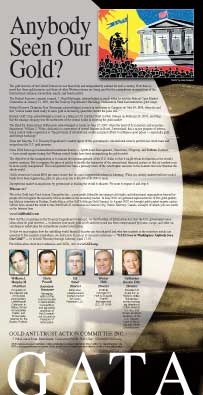You are here
A Monthly Review Of Gold From Frank Veneroso
Summary:
- Gold and Gold Equities: The near term is uncertain. The near-term path
of the dollar is unclear. The world is probably decelerating towards disinflation.
This could be a negative. - The ability of the gold futures market to absorb large spec liquidation
on a small price break is long term bullish. Perhaps, the official sector
is conducting an orderly retreat. - As opposed to our very positive supply/demand framework, the official
gold supply/demand framework is not especially constructive. It now diverges
so much from historical trends and abundant anecdotal information, that it
has become discredited.
First, The Big Picture...
We stated in our fourth quarter letter to certificate holders of the ABN Amro
gold certificate:
Recent developments now make us even more bullish on gold longer term.
We also believe that, owing to the recent correction, the shorter-term risks
have abated. (See below.)
Yet, on balance we fear the shorter-term downturn in the gold price since
late last year may remain in force. In addition, we are concerned that, late
last year, the global economy outside the U.S. (Japan, Europe, even China) began
to slow, and that this may be the beginning of a major cyclical shift from global
reflation to disinflation.
The global bond market seems to sense this. But other markets have not.
Such a shift could prove costly to reflation plays. Gold and gold equities would
probably not go unscathed. Lastly, owing to a severe fall off in interest in
the junior golds, this sub sector faces special risks should the overall gold
sector fall further.
That said, let us go on to the longer-term bullish case.
The Intermediate- To
Longer-Term Looks More Bullish
From our quarterly letter:
We regard the recent reduction in the net spec long position on Comex
to below prior reaction lows (38,000 versus 50,000) on a fairly modest (10%)
break in the gold price as very bullish
Why? At this point it is appropriate to bring up our basic supply/demand framework
for the gold market, which was laid out in our 1998 Gold Book and in several
papers that we have written in the intervening years. We believe that fabricated
demand and bar hoarding in the gold market has exceeded mine and scrap supply
by a much larger margin than is reflected in the Gold Fields Mineral Services
official supply/demand balances.
Second, the size of the net spec long positions in the futures and forwards
markets in recent years has been larger than at any point in the past including
the 1970s. Remember, trading volumes in the OTC gold market are more than 10
times what we see on Comex, and total derivative positions may be comparably
larger than Comex positions. (See our Gold Book).
Speculative purchases of this magnitude have no obvious offset. In the past,
producers offset such purchases with forward sales; but in recent years, they
have become buyers through reductions in their forward sales positions. There
is only one possible explanation for why purchases of thousands of tonnes of
gold in the futures and forwards markets does not blow the price of gold sky
high: The official sector must step in on gold price rallies as an offsetting
forward seller.
It is for these above reasons that we have long contended that the gold market
is a managed market. GATA attributes this management to a combination of bullion
dealers and official entities. We believe it is only the latter. If anything,
investment bank prop desks have been long gold in recent years, in keeping with
their overall bearish stance on the dollar. As we have written in the past,
we do not understand the motivations behind such official intervention, but
simple inference and abundant collateral evidence makes us convinced gold
is a managed market.
The official sector hoard of gold is very large, but it is not infinite. It
is obvious that someday it will be depleted and the gold price will trade higher
once official supplies no longer flow. We also know that the central banks will
not sell and lend all their gold.
Therefore, the end of official supplies will come long before the official
hoard is depleted. Because we have long contended that the gold market is in
a larger deficit (between fabricated demand and bar hoarding, on the one hand,
and mine and scrap supply, on the other) we have argued that this end of official
supplies will come sooner than the consensus believes. When these supplies dry
up, even if there is no Western investment demand, the price of gold will trade
at its commodity equilibrium, which we believe exceeds $600 an ounce. If there
is Western investment demand and there will be in the future the gold price
will trade far higher.
With this framework in mind, we can explain why we view the recent sharp reduction
in the Comex net spec long position on only a 10%, or $50 decline in the price
of gold as bullish.
Remember, we said the gold market is a managed market. Official supplies of
size are needed to meet the deficit of physical demands over mine and scrap
supply. Secondly, the official sector must be a forward seller to contain the
price of gold in the face of massive speculator forward buying. If the official
sector did not cover its forward sales on price declines and did not let up
on its flow of physical supplies, the gold price would collapse once the herd
of trend following speculators dumped their derivative longs. On the two price
peaks in gold in 2004, with record spec long positions, we feared this might
happen. But it hasnt. Somehow the gold price has been well contained on breaks
in the face of such long liquidation. This signifies to us that the official
sector is now reigning in its forward and physical supplies rather quickly on
price breaks.
At a recent gold conference in Vancouver GATA made the following assessment:
The official sector is engaged in an orderly retreat. We cannot be sure about
this, but the ability of the gold market to hold up so well in the face of massive
spec liquidation suggests that GATA may be correct. Remember, the official sector
hoard is limited, and the central banks will not sell all their gold. One sign
that the end of official management may be approaching might be the recent constructive
gold price action in the face of severe long liquidation by weak handed specs.
The Less-Bullish Official
Supply/Demand Framework Is Discredited
The above analysis is based on our supply/demand framework. People ask us,
how can you be sure your supply/demand framework is correct. The official statisticians
have so much more information to base their very different, much less positive,
statistical framework upon. Our answer is simple: Their gold supply/demand data
contradicts so much available information on the gold market it has lost all
credibility.
As I explained in the Gold Book, gold demand had been understated for years
by GFMS, the official keeper of the global gold statistics, as has been the
flow of official sector gold. Official stocks were falling faster than the GFMS
data would suggest. I presented abundant statistical information to make that
case. We believe that the trend in the official data since then simply flies
in the face of obvious facts and this discredits it further.
People ask us where we think supply and demand are now. Our standard response
is that we dont know, because the data available to us has become ever less
reliable. In the old days, the World Gold Council produced a data series on
gold demand for most (but not all) of the world. It was based on extensive survey
data and it had no reason to be biased. It clearly showed a stronger trend in
the growth of gold demand (excluding Western investment) than did the GFMS supply/demand
statistics. For us it was an anchor that allowed us to see a growing error in
the GFMS data (see the Gold Book).
In the 1990s GFMS was faced with a problem. From the late-1980s to the late-1990s,
there was a growing flow of borrowed gold associated with speculative short
sales, the hedging of central bank options and commercial inventory hedging,
in addition to the well recognized producer forward selling. There were also
some official sector liquidations that were not reported. These totaled to extremely
large official supplies. For some strange reason GFMS refused to acknowledge
most of these official supplies, particularly those associated with speculator
short sales. This resulted in a gross understatement of annual supplies.
Unlike the World Gold Council, which tried to only come up with an estimate
of demand, GFMS estimated both supply and demand. In the end GMS had to make
their estimates of demand and supply balance. Because they were underestimating
supplies to an increasing degree, they had to underestimate demand to an increasing
degree to make these accounts balance. That is why the World Gold Council survey
showed a stronger gold demand trend in the 1990s than the GFMS statistics.
Several years ago the World Gold Council decided to merge its statistical efforts
with GFMS leaving us, in effect, with only the GFMS supply/demand estimates.
It has been my opinion that the GFMS balances became so flawed by the end of
the 1990s that they had become virtually worthless. Therefore, Ive regarded
the new World Gold Council/GFMS statistics in recent years as basically useless.
We no longer have any anchor for estimating gold demand and supply.
I believe the most recent GFMS statistics are now distorted to the point of
the ridiculous. Let me illustrate.
Below are the GFMS supply/demand data for 1995 and 1996 (published at a time
when the gold price averaged approximately $390.00 an ounce) and the more recent
data for 2003 and 2004 (when the dollar gold price has been somewhat higher).
In the interim, there has been some global inflation and some dollar depreciation.
Therefore, in real inflation adjusted terms in a relevant global basket of currencies,
the gold price over the last two years is probably a little below the level
that prevailed in 1995 and 1996.

We know that, in over 200 years of history, private demand for gold (excluding
gold as a monetary metal in the hands of the public) has been positively correlated
with income and negatively correlated with the real gold price. In the Gold
Book, I showed that, for a constant real gold price, gold demand has tended
to rise in line with global income. In the economic jargon, we say that gold
has had an income elasticity slightly greater than unity. Many studies have
shown that such demands for gold are also reasonably price elastic. That is,
when the real price of gold falls, for the same amount of global income, demand
tends to rise. (See the Gold Book for the supporting data and analysis.)
Let us apply these simple concepts to the last eight years. From 1995-1996
to 2003-2004, global real income has risen by a little more than 3% a year,
or roughly 30%. Given gold demands past unitary price elasticity, this would
suggest perhaps a 30% rise in gold demand. As I have said above, the real price
of gold in a basket of currencies probably fell over this period. Given golds
significant price elasticity, this would suggest that global gold demand rose
by an even greater amount than 30%.
Has anything like this happened? If one listens to dealers and refiners, yes,
something like this has happened. We hear reports of ever-rising gold demand
in India and in the Middle East. And the big refineries in Switzerland are apparently
running flat out, producing more gold for the market than they ever have.
John Brimelow has provided us with the following data on
gold imports into Turkey. They averaged 100 tonnes a year
in 1995-1996. They are running at a 300-tonne rate so far
this year. Sure, Turkey as a center for distribution into
the Middle East no doubt reflects a demand trend way above
the global average. But how likely is it that gold demand
in the rest of the world fell even more than GFMS reports
in order for their global estimates to square with the huge
demand growth in the Turkish regional market?

Click on Chart for Larger Version
But what does GFMS tell us about gold demand? They tell us that, despite a
rise in global incomes of almost a third and a likely small real price decline
in the relevant basket of currencies, global gold demand, excluding Western
investment demand, has actually fallen. Their estimate of gold demand for the
year 2003 is particularly suspect. In that year, the real price of gold in the
relevant basket of currencies was surely much below the comparable price of
gold in 1995-1996. And yet, GFMS tells us that gold demand fell by almost 10%
from the mid-1990s to 2003, amidst a large rise in real global income.
Why is GFMS giving us demand estimates that are so out of keeping with all
historical demand trends, as well as the anecdotal evidence we get from refiners
and from consuming regions like the Middle East and India? The answer once again
lies in GFMSs completely erroneous estimates of supply and their felt need
to pull down their demand estimates so that it squares with these erroneous
supply estimates.
In the 1990s, GFMS correctly recognized that producer hedging took physical
gold out of central bank vaults by way of the lending process, and made it available
for fabrication. Their basic error was that they did not admit the same for
other types of gold borrowings. But now they have a very serious problem. Producers
are now reducing their gold borrowings. As I have explained in many papers and
the Gold Book, it is not possible for the gold that has been lent and then fabricated
into jewelry to be returned to the central banks without blowing the lid off
the gold market. We assume that, as with the covering of the large outstanding
volumes of speculator shorts in 1998 and 1999, producer forward short positions
have simply been transferred to the books of the official manager of the gold
market.
But GFMS is assuming that repayments of producer gold loans does take physical
gold out of the market, that it results in a negative supply flow. This greatly
reduces their estimate of aggregate physical supply. They are trying to make
up for this by now reporting record high official sector sales. They are also
estimating record flows of gold scrap.
The latter makes no sense. They are now carrying scrap flows that are 40% higher
than 1995-1996. At the same time, their estimate of fabrication demand is down.
Yet, most scrap has been recycled jewelry and has tended to move with the trend
in jewelry fabrication demand. In fact, scrap flows of all kinds have tended
to move in tandem in percentage terms with fabrication demand flows. Because
scrap flows are also price elastic, they have usually surged above trend when
the real price of gold went to new highs. But in 2003, the real price of gold
was below the level of 1995-1996. And yet GFMS has an estimate of scrap supply
that is almost 50% greater than that of 1995-1996.
Despite these heroics on the part of GFMS to push up their estimates of official
sector and scrap supplies, their treatment of the reductions in producer hedges
as a negative supply flow results in an overall contraction of aggregate physical
supply from 19951996 to 2003-2004. Nothing like that has happened. The refiners
will tell you that. But that is where their faulty handling of the supply side
for a decade and a half has now taken them.
Faced with this contraction in their estimate of supply, they must assume a
contraction in demand to make their balances balance. That is why they estimate
lower fabrication demand today than eight years ago, despite a very large increase
in real income and something of a decline in the relevant measure of the real
gold price. That is why they tell us that demand has fallen now over the last
eight years, even though people in the marketplace tell us that Middle East
and Indian demand is booming and that the refineries are humming like they have
never hummed before.
The GFMS estimates of gold demand are so removed from historical trends and
current market reports that they have become ludicrous. In a sense, with their
recent statistical shenanigans, GFMS has now fully discredited itself.
We no longer have an anchor for estimating gold supply/demand. But we are not
at all bothered by the fact that the official GFMS data goes in a direction that
is diametrically opposed to our estimate of market trends. Abundant market reports
support our overall assessment and we will go with them.
Note: Frank Veneroso is a Global Market Strategist advising Allianz Dresdner.
He also manages two funds. Over more than three decades as a top-level market
economist and fund manager, Mr. Veneroso has advised countless governments,
as well as the World Bank, on economic policy, served as a senior partner in
one of the worlds largest hedge funds, and is a confidant and private advisor
to many of todays most influential investors and economic leaders. In 1998,
he authored the ground-breaking Gold Book, detailing how years of central bank
gold loans and sales had artificially depressed the gold price, and positioned
the metal for a powerful rebound. Mr. Veneroso graduated cum laude from Harvard
University. VENEROSOS VIEW 7 MARCH 2005








